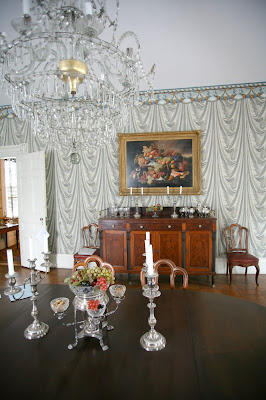By Anne Dealy, Director of Education and Public Information
African Americans have
celebrated American freedoms since well before the nation recognized their
right to share in those freedoms. The earliest of these celebrations were a
form of political protest, as former slaves in the “free” North gathered,
usually in August, to protest their exclusion from the rights other Americans
celebrated on Independence Day. These festivities started after Great Britain freed her slaves in the West Indies . The Emancipation Celebrations later
incorporated other advances in black civil rights, including the emancipation
of American slaves, the passage of the 13th, 14th, and 15th
Amendments to the Constitution, and the passage of various Civil Rights bills
and laws. Today Juneteenth is the most well-known of these festivals,
celebrating the date during the Civil War when African Americans in Texas
 |
| Members of |
Emancipation celebrations
were a vital part of Geneva Geneva ’s first
known African Americans, Cuffe and his wife Bett, were brought to the shore of Seneca Lake Virginia , bringing over 100 more
enslaved African Americans to the area surrounding Geneva Wayne , Ontario Ontario County had the largest black population of any county
in western New York
 |
Poster announcing the 1879 Emancipation Celebration in
|
Western New York
Emancipation Celebrations moved from town to town and were hosted by
Canandaigua, Auburn Geneva Pulteney
Park or Genesee Park Geneva ’s
African-American community read important documents from their crusade for
freedom: the act by which England Geneva , Rochester ,
Syracuse , Auburn ,
Lyons
 |
|
|
 |
Frederick Douglass spoke at many of Geneva’s Emancipation Celebrations. Image courtesy the National Portrait Gallery, Smithsonian.
|
Unfortunately for
historians, most existing accounts of these celebrations are filtered through
biased white perceptions. In her 1994 book Make
a Way Somehow: African-American Life in a Northern Community, 1790-1965,
historian Kathryn Grover teases out the possible meaning of these Geneva
When they reported on the
celebrations, the local papers invariably concentrated on the amusements and
social aspects of the festivities, rather than the political content that
underpinned the gatherings. At the 1860 celebration held in Geneva, Frederick
Douglass gave his first address since returning from Europe, where he had fled
after the arrest of John Brown, whom he called “the hero of Harper’s Ferry.” He
spoke of the example of the British in freeing their slaves in the West Indies
and his disappointment that the United States, with its proclamations of
liberty, continued to support slavery and the slave trade. He addressed an
audience that understood him when he said,
I have spoken and written much on the subject [of
slavery] during the last twenty years, and have been at times accused of
exaggeration; and yet I can say with truth, that I have fallen far short in
describing the pains and woes…. The warp and woof of slavery is yet to be
unraveled.—Each bloody thread must yet be disentangled and drawn forth, before
men will thoroughly understand and duly hate the enormity, or properly abhor
its upholders and work its abolition. This is the work still to be done. After
all the books, pamphlets and periodicals—after all the labors of the
Abolitionists at home and abroad—we have still to make the American people
acquainted with the sin and crime of our slave system.
Rather than focus on
Douglass’ arguments, the Geneva Gazette
newspaper emphasized Douglass’ “free ebullition and bile” in his criticism of
churches, political parties and society generally.”
After the Civil War and
Emancipation, Geneva newspapers devoted more space to celebrations that seem to
have lost their political force. At the same time that white southerners were
terrorizing African Americans in the post-Reconstruction South, the 1881 orator
never mentioned it. He focused on the African-American’s long history in the
country, his contrast to the Chinese immigrant laborer, and the importance of
his labor “where the white man cannot—in the warmest parts of the country,” in
the cotton fields, sugar plantations and iron foundries. He pointed out that
black Americans paid taxes and that progress that had been made in education.
At the same time, he reminded his audience (white and black) that “We are…just
as much within the circle of American citizenship as if we had come over in a
different manner [than as a captive]. The negro belongs here.” The writer went
on to detail the subsequent social events with no acknowledgment that this
citizenship was being denied across the country.
One of the last
celebrations in 1900, “hardly came up to those of former years” in attendance.
The audience was described as mostly white and attracted by the sporting
events. The decline of the Emancipation Celebration occurred as many African
Americans left Geneva and other small towns in the late 19th and
early 20th centuries for the opportunities available in larger
cities. The local community seems to have become too small and too focused on
survival to host large celebrations. This remained the case until the
post-World War II era.
For more information about
these celebrations and about Geneva’s African-American community, see the 1994
book Make a Way Somehow: African-American
Life in a Northern Community, 1790-1965 by Kathryn Grover.













